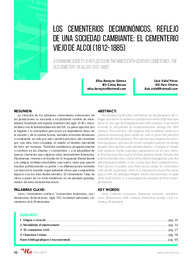Por favor, use este identificador para citar o enlazar este ítem:
https://hdl.handle.net/11000/6071Registro completo de metadatos
| Campo DC | Valor | Lengua/Idioma |
|---|---|---|
| dc.contributor.author | Beneyto Gómez, Elisa | - |
| dc.contributor.other | Departamentos de la UMH::Ciencias Sociales y Humanas | es |
| dc.date.accessioned | 2020-07-07T11:04:39Z | - |
| dc.date.available | 2020-07-07T11:04:39Z | - |
| dc.date.created | 2019 | - |
| dc.date.issued | 2020-07-07 | - |
| dc.identifier.issn | 2659-5362 | - |
| dc.identifier.uri | http://hdl.handle.net/11000/6071 | - |
| dc.description.abstract | La creación de los primeros cementerios extramuros de las poblaciones va asociada a un profundo cambio de mentalidad, heredado del espíritu ilustrado del siglo XVIII y desarrollado con la industrialización del XIX. La preocupación por la higiene y la salubridad provocarà un alejamiento físico de la muerte y, de la misma forma, también el recinto destinado a contenerla; no solo por una cuestión práctica, sino también por una idea más compleja: el miedo al destino inevitable de todo ser humano. También asistiremos progresivamente a cambios en los rituales y costumbres, y a la pluralidad de nuevas creencias que originan otras necesidades funerarias. Finalmente, veremos el triunfo de la burguesía liberal frente a la antigua nobleza absolutista, una nueva clase que querrá mostrar públicamente su poder y su diferenciación también a la hora de la muerte, especialmente ahora que compartirán espacio con los más desfavorecidos. El Cementerio Viejo de Alcoi, a pesar de su corta existencia, es un ejemplo paradigmático de estas transformaciones. | es |
| dc.description.abstract | The location of the first cemeteries on the periphery of villages and towns is linked to a profound mental shift that took place in the Age of Enlightenment (18th century) and which evolved in the period of industrialization during the 19th century. The concern with hygiene and sanitation leads to a physical distancing form death as well as from the precinct intended for that purpose. This did not only happen for practical purposes, but also for more complex reasons involving people’s fear of their unavoidable destiny. Changes in rituals and customs make a gradual appearance as do new beliefs that become the source of other funeral needs. Finally, the article considers the victory of the liberal bourgeoisie over the old absolutist nobility. A new social class that wanted to show their power in public and their social status in connection with death, especially when it is destined to share the same space with the underprivileged. Alcoi’s old cemetery, in spite of its brief history, is a paradigmatic exemple of these transformations. | es |
| dc.format | application/pdf | es |
| dc.format.extent | 9 | es |
| dc.language.iso | spa | es |
| dc.relation.ispartofseries | 1 | es |
| dc.rights | info:eu-repo/semantics/openAccess | es |
| dc.subject | Alcoi | es |
| dc.subject | Cementerio católico | es |
| dc.subject | Costumbres funerarias | es |
| dc.subject | Academicismo | es |
| dc.subject | Eclecticismo | es |
| dc.subject.other | CDU::3 - Ciencias sociales::39 - Etnología. Etnografía. Usos y costumbres. Tradiciones. Folklore | es |
| dc.title | Los cementerios decimonónicos, reflejo de una sociedad cambiante: el Cementerio Viejo de Alcoi (1812-1885) | es |
| dc.type | info:eu-repo/semantics/article | es |
| dc.identifier.doi | 10.21134/ewali.v0i1.1678 | - |
| dc.relation.publisherversion | https://doi.org/10.21134/ewali.v0i1.1678 | - |

Ver/Abrir:
1678-4966-1-PB.pdf
2,39 MB
Adobe PDF
Compartir:
 La licencia se describe como: Atribución-NonComercial-NoDerivada 4.0 Internacional.
La licencia se describe como: Atribución-NonComercial-NoDerivada 4.0 Internacional.
.png)